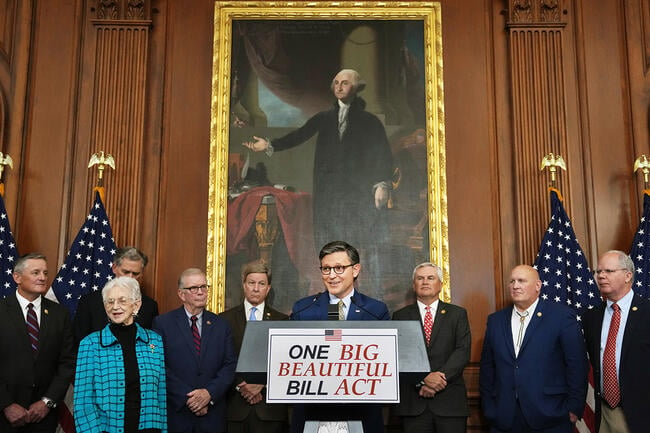You have /5 articles left.
Sign up for a free account or log in.

House Republicans passed the bill with a vote of 215 to 214. One member voted present and two others didn’t vote.
Kevin Dietsch/Getty Images
After much back-and-forth and late-night dealing, House Republicans have passed a sweeping budget plan to cut spending and taxes that is moving on to the Senate—a significant milestone for legislation that seemed dead in the water a week ago amid concerns that the bill didn’t include deeper cuts.
The plan, called the One Big Beautiful Bill Act, narrowly advanced Thursday morning by a one-vote margin. All Democrats opposed the legislation, arguing that the spending cuts would hurt the working class and vulnerable populations while raising the deficit and giving tax breaks to wealthy individuals.
Among other changes, the legislation would levy new taxes on colleges, require institutions to pay millions to the federal government, change how students pay for college and limit eligibility for the Pell Grant. In the lead-up to Thursday’s vote, higher education leaders warned that the proposal would make trying to attend and pay for college much more complicated and raise costs for those who do enroll. The bill does include some wins for colleges, institutional lobbyists say, but those don’t outweigh the negatives.
Republicans, who say the cuts are necessary, are using a legislative procedure known as reconciliation to advance the bill. That process allows lawmakers to fast-track the legislation and pass it with a simple majority of votes in both chambers. (Typically, the Senate requires 60 votes to cut off debate for a bill.)
“It’s time we stopped asking a factory worker in Michigan or a rancher in Texas to subsidize the student debt of a lawyer in Manhattan so colleges can continue to spike their tuition to whatever they want,” said Rep. Tim Walberg, a Michigan Republican and chair of the House Committee on Education and the Workforce, in a statement. “By capping loan amounts and giving some financial responsibility to schools, this legislation addresses the root cause of high college costs and provides schools an incentive to deliver real value for students and taxpayers.”
With the measure now in the Senate’s hands and lawmakers eyeing a July 4 deadline, here’s what else you should know about the legislation that could reshape American higher education.
1. Students Set to Lose Pell Money
Many House committees had a hand in the legislation, but the proposals that will have the biggest impact on colleges are from the Committee on Education and the Workforce. The 103-page Student Success and Taxpayer Savings Plan, which is part of the broader reconciliation bill, would reduce spending by nearly $350 billion over the next 10 years.
Most of those savings stem from rolling back a Biden-era student loan repayment plan that never fully took effect and from capping how much students can borrow. But lawmakers are also planning to increase spending on Pell Grants by $2.8 billion as they aim to address a looming shortfall and open up the program to short-term workforce-training classes.
To make the math work, Republicans are changing who qualifies for a Pell Grant, proposing that students would have to take at least 15 credits a semester in order to receive the full award. They’ll also have to take at least 7.5 credits to get any money. Currently, the Pell Grant is prorated based on how many credits students take, and there’s no floor.
Changing the full-time-award definition would save $7.1 billion, according to the Congressional Budget Office, which estimated that more than half of students currently enrolled would see their Pell Grant reduced.
The CBO also estimated that cutting off Pell for part-time students would save about $687 million over the next 10 years. Currently, about 10 percent of Pell Grant recipients enroll less than half-time. Of those students, the CBO predicts that one-third of students who stand to lose their grant under this change would enroll in more classes. Presumably, the other two-thirds would either stop out or pay for their education with loans or their own money. (The CBO report was based on a minimum of six credits, but that threshold has since increased to 7.5, so the number of students affected could be higher.)
Over all, about 700,000 students would no longer be eligible for the Pell Grant after all the changes take effect. The changes are currently set to take effect in summer 2026.
2. Colleges on the Hook for Unpaid Student Loans
In addition to the Pell Grant cuts, college leaders are particularly worried about a provision known as risk-sharing, which would require institutions to pay a financial penalty based on students’ unpaid loans. How much colleges would have to pay is unclear, but the CBO estimates that by 2034, payments would total $1.3 billion and then continue to increase each year. Risk-sharing is expected to save the government $5.3 billion over the next 10 years.
Because of risk-sharing and other changes in the bill aimed at limiting student borrowing, the CBO predicts that the volume of student loans would drop by about 20 percent.
College leaders and lobbyists argue that the formula that would determine institutions’ payments is untested, and without more information, they can’t accurately gauge the ramifications. One lobbyist said the proposal represented “an astonishing level of federal overreach.” Critics of the plan also worry that underresourced and minority-serving institutions would be hit the hardest.
“The risk is not equal among colleges,” Tuskegee University president Mark Brown told senators this week.
Risk-sharing is just one of several proposed changes that would upend the student loan system. House Republicans also want to end Grad PLUS loans along with subsidized loans, restrict Parent PLUS loans and tie how much students can borrow to the median cost of a program. Some consumer protection advocates argued that these changes would drive students to private lenders, which often charge higher interest rates.
3. More Taxes and Medicaid Cuts Threaten Colleges’ Bottom Lines
Other proposals in the bill from the Ways and Means Committee would levy a host of new or expanded taxes against universities.
First, the committee created new brackets to tax wealthy universities’ endowments. Currently, private universities with endowments that are worth more than $500,000 per student pay a 1.4 percent tax. But under the plan, some could see their endowments taxed at 21 percent.
Institutions with endowments valued at $750,000 to $1.25 million per student would be hit with a 7 percent tax. That rate would climb to 14 percent for colleges with endowments worth $1.25 million to $2 million per student, while colleges with endowments of $2 million or more per student would pay 21 percent. Colleges also can’t include international students in their tally of students, which could subject more institutions to the tax.
In addition to the endowment tax, the proposal also taxes a college’s intellectual property by stating that the endowment tax should include all forms of investment income. This means that any royalties from a private university’s intellectual property, including patents and copyrights, would be taxable. Additionally, the legislation removes colleges’ exemption from the unrelated business income tax so that all institutions, public and private, would be taxed for royalties from licensing their name and logo.
House Republicans in other committees also proposed cuts to the Medicaid and Supplemental Nutrition Assistance programs, which critics say would hurt students and states’ budgets. And if states do take a hit financially, public colleges might see their budgets cut.
“If federal Medicaid funding is reduced in a new federal tax law, no public college or university will be immune from future state budget reductions and the austerity that will result. Public higher education must be prepared,” two professors wrote in an Inside Higher Ed op-ed earlier this year.
4. Warnings From Higher Ed Pile Up
Higher education groups warned before and after the vote of damaging consequences if the legislation becomes law.
American Federation of Teachers president Randi Weingarten called it a “big, ugly betrayal,” while Kara D. Freeman, president and CEO of the National Association of College and University Business Officers, said in a statement that “the implications for student access, research, and innovation could be far-reaching.”
Freeman said the endowment tax is especially concerning and cited NACUBO data that shows colleges and universities spent $30 billion from their endowments in fiscal year 2024—nearly half of which funded student financial aid.
“This scholarship tax takes funds away from students and makes it less possible for colleges to support them,” she said.
Meanwhile, the American Council on Education took issue with the use of the reconciliation process to advance sweeping changes, along with the provisions in the bill.
“The totality of the funding cuts, policy changes, and tax increases included in this reconciliation package will have a historic and negative impact on the ability of current and future students to access postsecondary education, as well as on colleges and universities striving to carry out their vital educational and research missions,” ACE wrote in a letter to the House.
So far, senators have said little about the higher ed provisions in the bill, so it’s not yet clear whether they’ll agree with the House plan. Generally, while the House prefers risk-sharing, the Senate is expected to back a measure that judges programs by their students’ employment rates and income levels after graduation.
But, with President Donald Trump backing the legislation and a fragile majority in the House, senators have few options if they want to change the legislation.
“This is arguably the most significant piece of Legislation that will ever be signed in the History of our Country!” Trump wrote on Truth Social. “Now, it’s time for our friends in the United States Senate to get to work, and send this Bill to my desk AS SOON AS POSSIBLE! There is no time to waste.”




